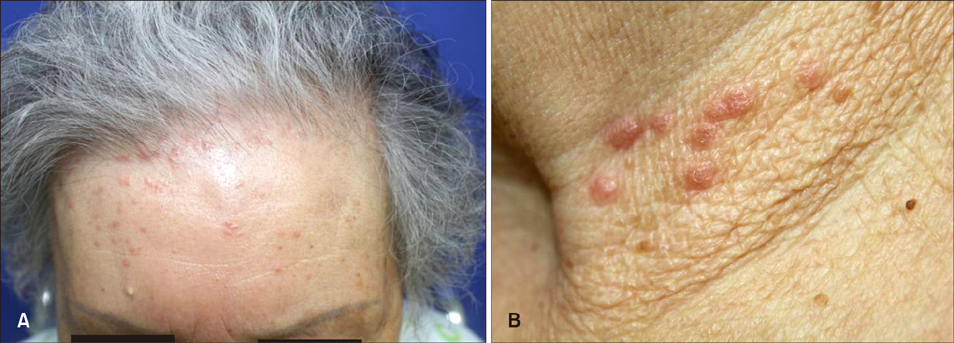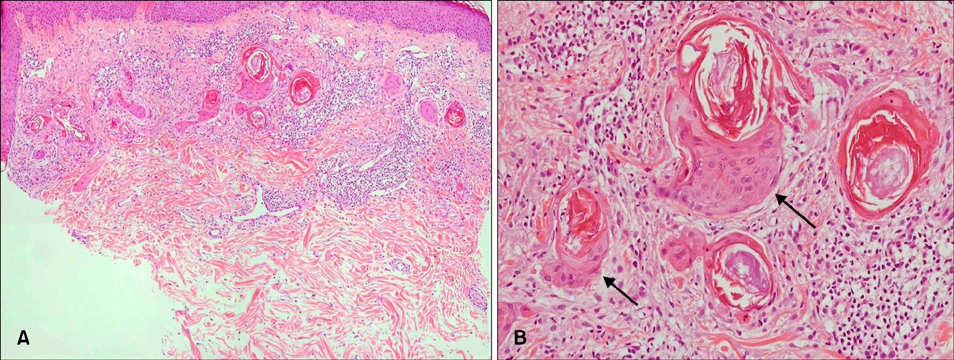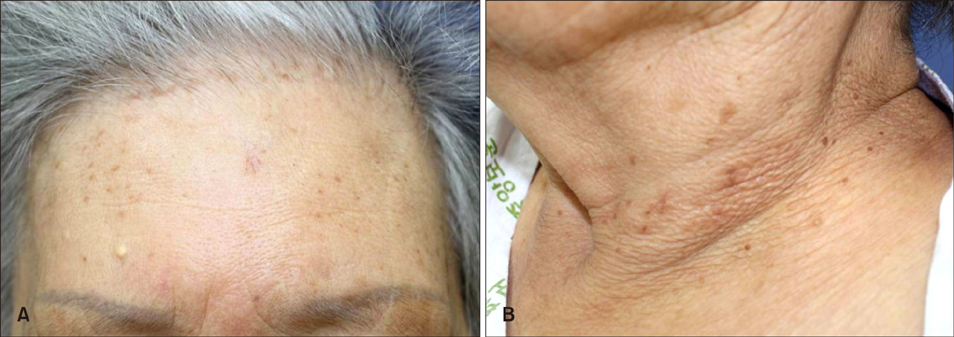Ann Dermatol.
2017 Jun;29(3):334-336. 10.5021/ad.2017.29.3.334.
Eccrine Squamous Syringometaplasia Associated with Pelubiprofen Therapy
- Affiliations
-
- 1Department of Dermatology, Veterans Health Service Medical Center, Seoul, Korea. zooooz@hanmail.net
- KMID: 2378535
- DOI: http://doi.org/10.5021/ad.2017.29.3.334
Abstract
- Eccrine squamous syringometaplasia (ESS) is a histologically distinctive skin eruption occurring predominantly in acral or intertriginous areas presenting as erythematous macules, papules or patches. The etiology of ESS remains unclear, but it is usually reported in patients receiving chemotherapy for various malignant neoplasms. To date, only two cases of ESS associated with non-steroidal anti-inflammatory drugs (NSAIDs), which has distinctive clinical features and pathogenesis, have been reported in the literature. Herein, we report a rare and interesting case of ESS associated with pelubiprofen, a recently developed NSAID, which appeared after pelubiprofen therapy and resolved spontaneously after discontinuing the medication.
Figure
Reference
-
1. King DT, Barr RJ. Syringometaplasia: mucinous and squamous variants. J Cutan Pathol. 1979; 6:284–291.
Article2. Kim J, Kim SH, Lee MG, Chung KY, Kim DS. Eccrine squamous syringometaplasia of underlying syringoma associated with Tegafur/Gimeracil/Oteracil (TS-1). Acta Derm Venereol. 2015; 95:999–1000.
Article3. Martorell-Calatayud A, Sanmartín O, Botella-Estrada R, Balmer NN, Serra-Guillén C, Gomez-Moyano E, et al. Chemotherapy-related bilateral dermatitis associated with eccrine squamous syringometaplasia: reappraisal of epidemiological, clinical, and pathological features. J Am Acad Dermatol. 2011; 64:1092–1103.
Article4. Lerner TH, Barr RJ, Dolezal JF, Stagnone JJ. Syringomatous hyperplasia and eccrine squamous syringometaplasia associated with benoxaprofen therapy. Arch Dermatol. 1987; 123:1202–1204.
Article5. Gallo E, Llamas-Velasco M, Navarro R, Fraga J, García-Diez A. Eccrine squamous syringometaplasia secondary to cutaneous extravasation of docetaxel: report of three cases. J Cutan Pathol. 2013; 40:326–329.
Article6. Moreno de Vega MJ, Dauden E, Abajo P, Bartolome B, Fraga J, Garcia-Diez A. Skin necrosis from extravasation of vinorelbine. J Eur Acad Dermatol Venereol. 2002; 16:488–490.
Article7. Valks R. Siringometaplasia escamosa ecrina. Actas Dermosifiliogr. 2001; 92:13–24.
Article8. El-Fidawi G, Akel R, Abbas O. Eccrine squamous syringometaplasia in a patient with plaque-type morphea. J Cutan Pathol. 2014; 41:548–549.
Article9. Han KD, Oh CW, Yoon TJ, Kim TH. A case of phototoxicity due to hydrochlorothiazide. Ann Dermatol. 1998; 10:289–292.
Article10. Ljunggren B. Propionic acid-derived non-steroidal antiinflammatory drugs are phototoxic in vitro. Photodermatol. 1985; 2:3–9.




